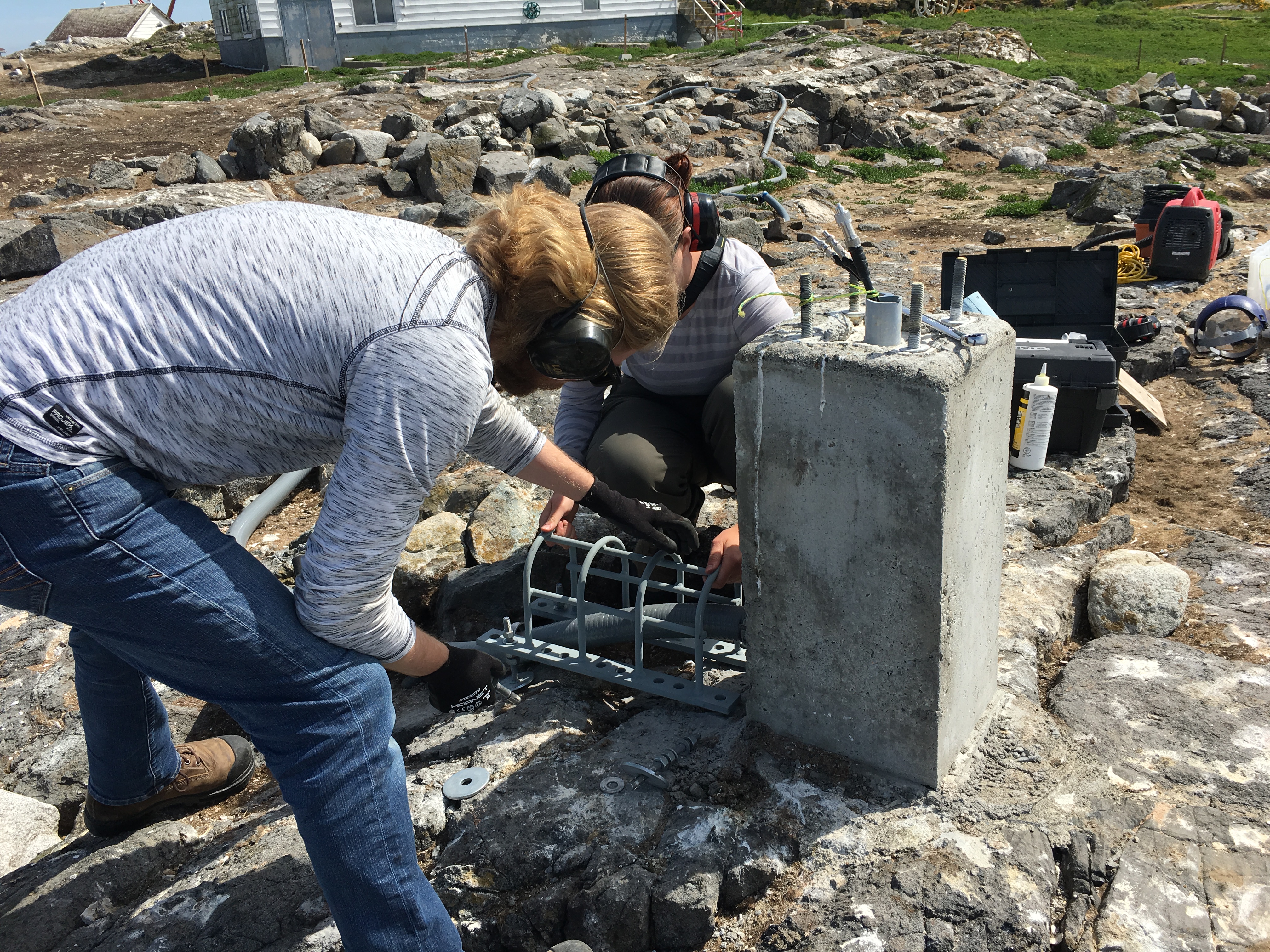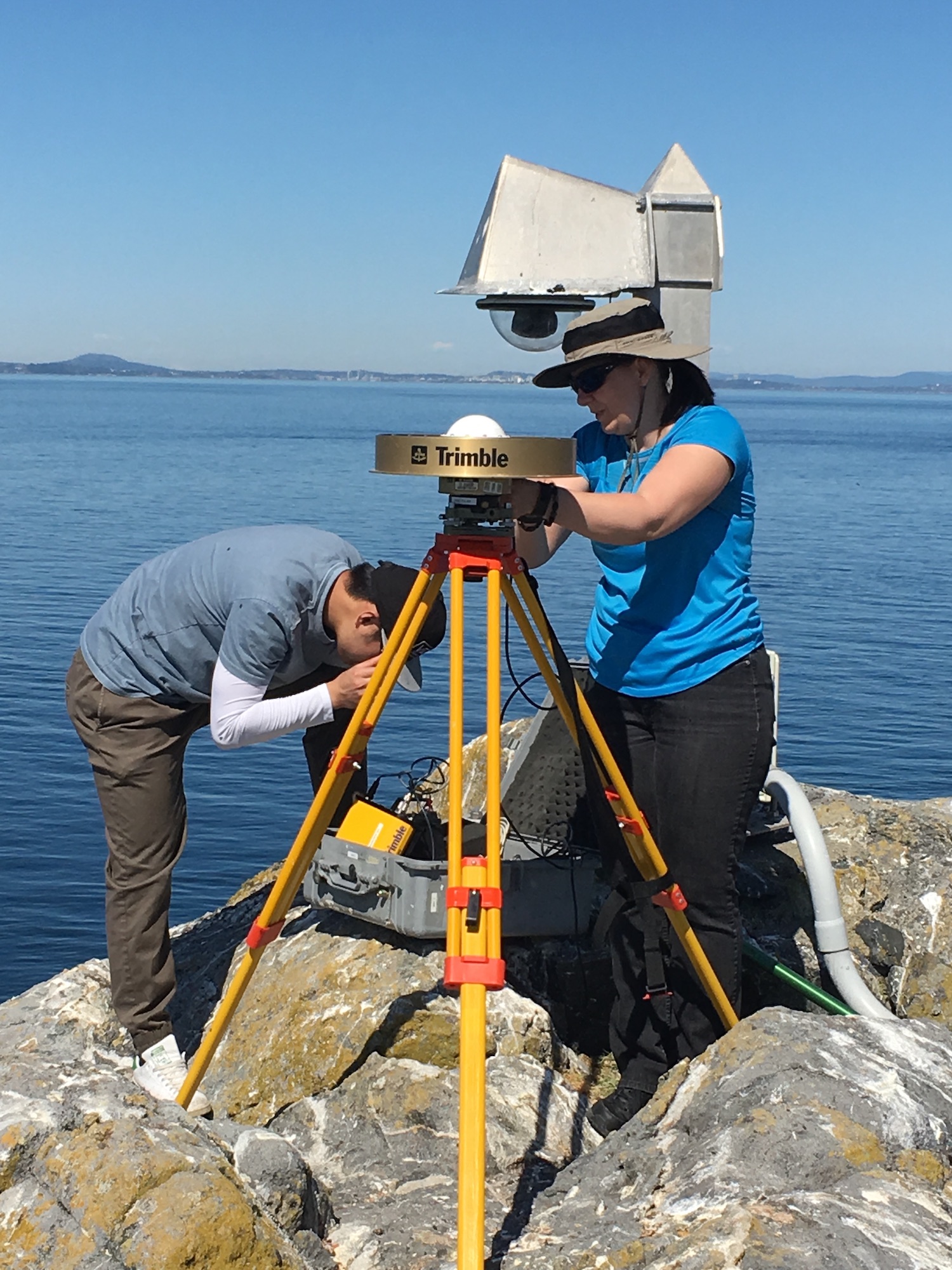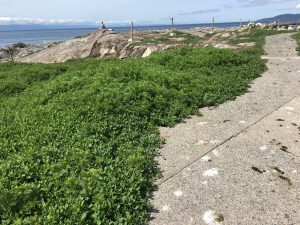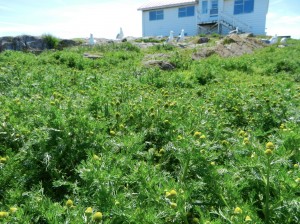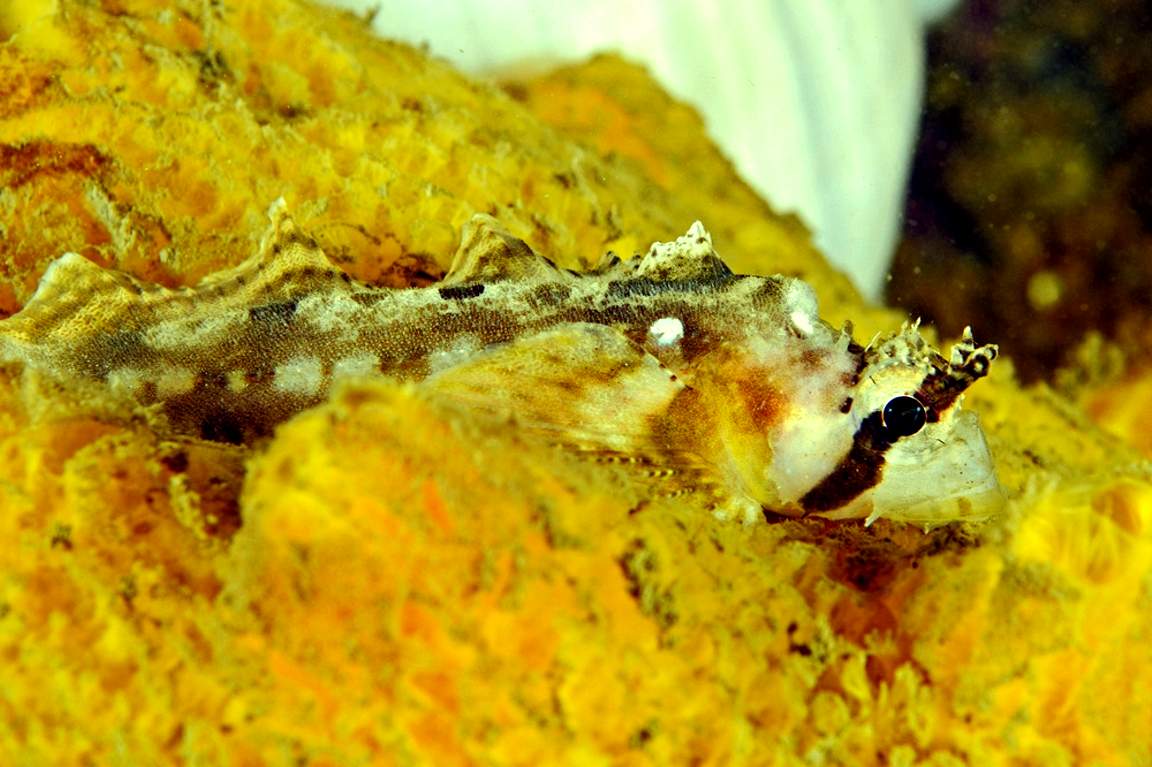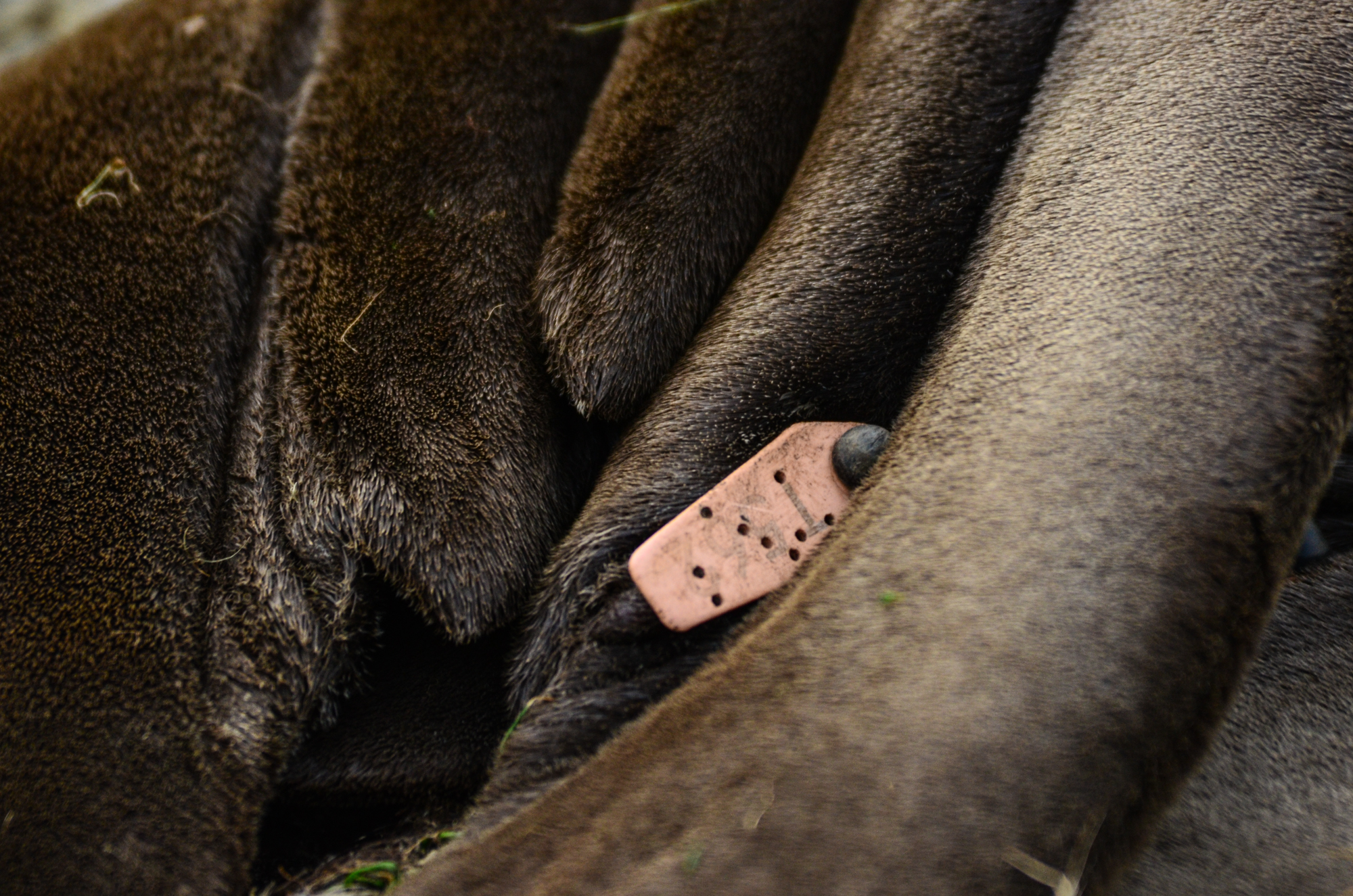Note, The blanks for the years 1940-41 are due to the Second World War. Apparently during that time, data was not collected by a lightkeeper.Original data was sent by the Lightkeepers and now by the Marine Protected Area Guardian of Race Rocks to the Institute of Ocean Sciences where it is compiled and displayed at
http://www.pac.dfo-mpo.gc.ca/science/oceans/data-donnees/lighthouses-phares/index-eng.htm
 Decade analysis by G. Fletcher.. NOTE probable evidence of climate change
Decade analysis by G. Fletcher.. NOTE probable evidence of climate change
Race Rocks Light Station: 48.2996 123.5318
| Year | Jan | Feb | Mar | Apr | May | Jun | Jul | Aug | Sep | Oct | Nov | Dec | |
| 1921 | — | 7.13 | 7.39 | 7.75 | 8.53 | 9.57 | 10.31 | 10.53 | 10.35 | 9.88 | 9.21 | 8.25 | |
| 1922 | 6.4 | 6.1 | 6.6 | 7.5 | 8.3 | 9.5 | 10.5 | 10.3 | 10.2 | 9.3 | 8.4 | 7.1 | |
| 1923 | 7.1 | 6.4 | 6.7 | 7.6 | 8.6 | 9.3 | 10.3 | 10.5 | 10.6 | 9.6 | 8.7 | 7.9 | |
| 1924 | 7.1 | 7.3 | 7.7 | 7.9 | 9 | 9.8 | 10.5 | 10.3 | 10.2 | 9.2 | 8.8 | 7.3 | |
| 1925 | 6.6 | 6.9 | 7.3 | 8 | 9.2 | 10.1 | 11.1 | 10.8 | 10.2 | 9.2 | 8.3 | 8.2 | |
| 1926 | 7.8 | 8 | 8.6 | 9.2 | 10.1 | 10.7 | 11.1 | 10.9 | 10.5 | 9.8 | 9.1 | 8.5 | |
| 1927 | 7.6 | 7.4 | 7.8 | 8 | 8.8 | 9.8 | 10.5 | 10.9 | 10.3 | 9.7 | 8.6 | 7.6 | |
| 1928 | 6.9 | 7.3 | 7.8 | 8.6 | 9.7 | 10.2 | 10.8 | 10.9 | 10.3 | 9.2 | 8.6 | 7.9 | |
| 1929 | 7.1 | 6.3 | 7.1 | 7.8 | 9 | 9.8 | 10.8 | 10.8 | 10.7 | 9.8 | 8.8 | 7.8 | |
| 1930 | 6.5 | 6.6 | 7.1 | 8.2 | 9.3 | 10 | 10.6 | 10.8 | 10.6 | 9.4 | 8.6 | 8 | |
| 1931 | 7.8 | 7.8 | 8.2 | 8.8 | 9.9 | 10.6 | 11.5 | 11.1 | 10.7 | 9.6 | 8.6 | 7.7 | |
| 1932 | 7.1 | 6.8 | 7.3 | 8.2 | 9.3 | 10.4 | 10.8 | 10.9 | 10.7 | 9.6 | 8.9 | 7.7 | |
| 1933 | 7.1 | 6.7 | 7.1 | 8 | 9.1 | 10.2 | 10.5 | 11.5 | 10.1 | 9.6 | 8.6 | 7.7 | |
| 1934 | 7.8 | 7.9 | 8.3 | 9.2 | 10 | 10.8 | 10.9 | 11.6 | 10.7 | 9.7 | 9.2 | 8.4 | |
| 1935 | 7.2 | 7.2 | 7.5 | 7.8 | 9.2 | 10.1 | 10.5 | 10.5 | 10.7 | 9.7 | 8.2 | 8.1 | |
| 1936 | 7.9 | 6.7 | 7 | 7.8 | 9.3 | 10.4 | 11.3 | 11.3 | 10.5 | 10.1 | 8.6 | 7.9 | |
| 1937 | 6.6 | 6.4 | 7.7 | 8.7 | 9.9 | 10.9 | 11.7 | 11.5 | 10.9 | 9.9 | 8.5 | 8.1 | |
| 1938 | 7.4 | 7.2 | 8.1 | 9.4 | 10.6 | 12.3 | 12.7 | 11.9 | 11 | 9.9 | 8.6 | 7.5 | |
| 1939 | 7.4 | 6.6 | 7.1 | 8.6 | 10.3 | 11.4 | 12.2 | 11.1 | 11.4 | 9.7 | –< | 8.5 | |
| 1940 | 7.98 | 8.28 | 9.06 | 10.09 | 11.49 | 11.69 | — | — | — | — | — | — | |
| 1941 | — | — | — | — | 10.87 | 10.54 | 11.29 | 11-05 | 10.66 | 9.97 | 9.07 | 8.60 | |
| 1942 | 7.9 | 7.9 | 7.8 | 8.5 | 9.6 | 9.8 | 10.5 | 11 | 10.3 | 9.5 | 8.4 | 7.9 | |
| 1943 | 6.8 | 6.7 | 7.1 | 8.2 | 8.8 | 10 | 10.3 | 10.6 | 10.3 | 9.6 | 9 | 8.1 | |
| 1944 | 7.7 | 7.5 | 7.3 | 8 | 9.2 | 10.5 | 11 | 10.9 | 10.5 | 9.6 | 9.2 | 8.1 | |
| 1945 | 7.8 | 7.7 | 7.6 | 8 | 8.8 | 9.8 | 10.1 | 10.5 | 10 | 9.5 | 8.1 | 8.1 | |
| 1946 | 7.7 | 7.3 | 7.7 | 8.1 | 9.4 | 10.2 | 10.7 | 10.8 | 10.3 | 9.4 | 8.1 | 7.7 | |
| 1947 | 7.1 | 7 | 7.7 | 8.4 | 9.5 | 10.4 | 10.6 | 10.9 | 10.5 | 9.9 | 9.1 | 7.9 | |
| 1948 | 7.5 | 6.9 | 7.2 | 7.9 | 9 | 10.2 | 10.8 | 10.7 | 10.4 | 9.5 | 8.2 | 7 | |
| 1949 | 6.1 | 6.1 | 6.9 | 8.3 | 9.4 | 10.1 | 10.3 | 10.2 | 10.5 | 9.5 | 8.7 | 7.8 | |
| 1950 | 6.2 | 5.8 | 6.6 | 7.7 | 8.7 | 9.4 | 10.1 | 10.4 | 10.3 | 9.3 | 8.5 | 8 | |
| 1951 | 7.5 | 6.9 | 6.7 | 8.1 | 9.2 | 10.2 | 10.4 | 11.1 | 10.9 | 9.5 | 8.5 | 7.7 | |
| 1952 | 6.9 | 7.1 | 7.6 | 8.2 | 9 | 9.6 | 10.4 | 10.5 | 10.2 | 9.8 | 8.6 | 7.9 | |
| 1953 | 7.8 | 7.9 | 7.6 | 8.1 | 9.3 | 9.8 | 10.6 | 11 | 10.6 | 9.9 | 9.3 | 8.5 | |
| 1954 | 7.1 | 7.3 | 7.5 | 7.9 | 8.7 | 9.3 | 9.9 | 10 | 10 | 9.4 | 9.1 | 8.4 | |
| 1955 | 7.5 | 7.1 | 6.7 | 7.5 | 8.4 | 9.3 | 9.8 | 10.2 | 10 | 8.9 | 7.5 | 6.6 | |
| 1956 | 6.7 | 6.4 | 6.3 | 7.6 | 8.7 | 9.6 | 10.2 | 10.4 | 10.1 | 9.2 | 8.1 | 7.1 | |
| 1957 | 6.3 | 6.2 | 7.2 | 8.1 | 9.3 | 10 | 10.3 | 10.5 | 10.5 | 9.8 | 8.8 | 8.3 | |
| 1958 | 8 | 8.3 | 8.6 | 9.3 | 10.3 | 10.7 | 11.5 | 11.5 | 11 | 9.9 | 8.7 | 8.1 | |
| 1959 | 7.6 | 7.4 | 7.9 | 9.1 | 9.7 | 10.4 | 11.3 | 11 | 10.4 | 9.7 | 8.3 | 7.8 | |
| 1960 | 7.1 | 7.5 | 7.5 | 8.6 | 9.6 | 10.3 | 11.4 | 10.8 | 10.1 | 9.5 | 8.6 | 7.9 | |
| 1961 | 7.9 | 8.2 | 8.4 | 8.8 | 9.4 | 10.3 | 10.9 | 11.3 | 10.6 | 9.4 | 8.2 | 7.5 | |
| 1962 | 7.2 | 7.3 | 7.3 | 8.4 | 9.3 | 10 | 10.4 | 10.5 | 10.5 | 10 | 9.3 | 8.7 | |
| 1963 | 7.5 | 7.5 | 7.8 | 8.5 | 9.6 | 10.2 | 10.5 | 10.8 | 10.6 | 10.3 | 9.9 | 8.7 | |
| 1964 | 8.2 | 7.9 | 7.7 | 8.2 | 8.8 | 9.6 | 10.3 | 10.5 | 10 | 9.4 | 8.3 | 7.4 | |
| 1965 | 6.9 | 7.1 | 7.2 | 8 | 8.8 | 9.8 | 10 | 10.2 | 10.3 | 9.7 | 9.2 | 8.5 | |
| 1966 | 7.7 | 7.6 | 7.7 | 8.5 | 9 | 9.1 | 99.9 | 10.7 | 10.1 | 9.5 | 8.7 | 8.6 | |
| 1967 | 7.9 | 7.7 | 7.6 | 8.1 | 8.9 | 9.6 | 10.3 | 10.5 | 10.5 | 9.7 | 9.1 | 8 | |
| 1968 | 7.3 | 7.3 | 8 | 8.3 | 8.7 | 9.5 | 10.2 | 10.2 | 10.4 | 9.3 | 8.8 | 7.8 | |
| 1969 | 6.5 | 6.3 | 7.2 | 8.1 | 9.1 | 10.2 | 10.4 | 10.5 | 9.8 | 9.2 | 8.7 | 8.1 | |
| 1970 | 7.5 | 7.7 | 7.9 | 8 | 8.7 | 9.6 | 10.2 | 10.2 | 10 | 9 | 8.3 | 7.5 | |
| 1971 | 7 | 6.9 | 6.7 | 7.5 | 8.5 | 9.1 | 10 | 10.6 | 10.4 | 9.3 | 8.3 | 7.3 | |
| 1972 | 6.4 | 6.2 | 6.9 | 7.6 | 8.8 | 9.5 | 10.5 | 10.6 | 10.2 | 9.1 | 8.4 | 7.3 | |
| 1973 | 7 | 7.2 | 7.9 | 8.4 | 8.6 | 9.2 | 10.1 | 10.3 | 10 | 9.2 | 8.2 | 8 | |
| 1974 | 7.2 | 7.2 | 7.3 | 8.1 | 8.5 | 9.7 | 10 | 10.9 | 10.6 | 9.7 | 8.6 | 8.2 | |
| 1975 | 7.3 | 6.8 | 7.2 | 7.7 | 8.7 | 9.4 | 10.2 | 10.4 | 10.4 | 9.6 | 9.2 | 7.8 | |
| 1976 | 7.2 | 7 | 7 | 7.8 | 8.7 | 9.3 | 10.1 | 10.1 | 10 | 9.4 | 8.6 | 8.1 | |
| 1977 | 7.6 | 7.9 | 8 | 8.3 | 8.8 | 9.7 | 9.9 | 10.8 | 10.3 | 9.2 | 8.6 | 7.9 | |
| 1978 | 7.6 | 7.9 | 8.3 | 8.9 | 9.4 | 10.3 | 10.4 | 10.9 | 10.5 | 9.8 | 8.2 | 7.3 | |
| 1979 | 6.5 | 6.9 | 7.5 | 8.3 | 9.5 | 10 | 10.8 | 10.7 | 10.5 | 9.8 | 9 | 8.6 | |
| 1980 | 7.7 | 7.6 | 7.9 | 8.6 | 9.5 | 9.5 | 10.6 | 10.9 | 10.5 | 9.9 | 9.2 | 8.6 | |
| 1981 | 8.3 | 8.3 | 8.8 | 9.2 | 9.4 | 9.9 | 10.3 | 10.5 | 10.2 | 9.7 | 9.3 | 8.5 | |
| 1982 | 7.2 | 7.5 | 8 | 8.8 | 9.9 | 10.7 | 11.4 | 11.8 | 11.4 | 10.3 | 8.8 | 8.3 | |
| 1983 | 8.6 | 8.6 | 9.3 | 10 | 10.6 | 11.3 | 11.7 | 12.4 | 11.4 | 10.3 | 9.5 | 7.7 | |
| 1984 | 7.5 | 7.8 | 8.4 | 9 | 9.7 | 10.3 | 11.4 | 11.6 | 10.6 | 9.7 | 8.5 | 6.9 | |
| 1985 | 6.8 | 6.8 | 7.2 | 8.2 | 9.6 | 10.6 | 11.5 | 11.6 | 10.8 | 9.6 | 6.8 | 6.4 | |
| 1986 | 7 | 6.6 | 8 | 8.4 | 9.4 | 11 | 10.9 | 11.8 | 10.8 | 9.8 | 8.4 | 7.8 | |
| 1987 | 7.6 | 7.9 | 8.3 | 8.9 | 9.8 | 10.6 | 11.1 | 11.5 | 11.1 | 10 | 9 | 8.2 | |
| 1988 | 7.4 | 7.5 | 7.5 | 8.6 | 9.6 | 10.4 | 11 | 11.4 | 10.6 | 9.6 | 8.7 | 7.9 | |
| 1989 | 7 | 5.8 | 6.8 | 8.2 | 9.5 | 10.7 | 11.3 | 11.2 | 11 | 9.9 | 8.9 | 8.2 | |
| 1990 | 8.1 | 7.7 | 8.2 | 9 | 9.9 | 10.8 | 11.8 | 12.1 | 12.1 | 10.7 | 9.9 | 8.2 | |
| 1991 | 7.1 | 7.7 | 7.9 | 8.4 | 9.7 | 9.7 | 10.8 | 11 | 11.2 | 10.1 | 8.9 | 8.3 | |
| 1992 | 7.9 | 8.1 | 9.5 | 9.5 | 10.2 | 10.7 | 11.1 | 11.4 | 11 | 10 | 9.1 | 7.8 | |
| 1993 | 6.7 | 6.7 | 7.6 | 8.6 | 9.7 | 10.8 | 11 | 11.2 | 11 | 10.1 | 8.5 | 7.9 | |
| 1994 | 8 | 7.4 | 8.6 | 9.3 | 10.1 | 10.6 | 11.6 | 11.5 | 11.3 | 10.7 | 9.3 | 8.4 | |
| 1995 | 8.2 | 8.6 | 8.8 | 9.2 | 10.2 | 11.2 | 11.8 | 11.5 | 11.3 | 10.2 | 9.4 | 8.9 | |
| 1996 | 8.2 | 7.8 | 8.4 | 9.2 | 10 | 10.4 | 11.5 | 11.5 | 10.5 | 9.9 | 8.7 | 7.6 | |
| 1997 | 7.7 | 7.9 | 8.1 | 9 | 10.3 | 10.9 | 11.7 | 12.2 | 11.6 | 11.3 | 9.9 | 9.3 | |
| 1998 | 8.7 | 9.2 | 9.7 | 9.9 | 10.4 | 11.4 | 11.7 | 12.3 | 12.1 | 10.7 | 9.8 | 9 | |
| 1999 | 8 | 7.8 | 8.1 | 8.9 | 9.5 | 10.4 | 11.1 | 11.5 | 11.9 | 10.1 | 9 | 8.5 | |
| 2000 | 7.5 | 7.7 | 8.1 | 9.1 | 10 | 11.1 | 11.3 | 11.7 | 11.4 | 10.3 | 9 | 8 | |
| 2001 | 7.9 | 7.7 | 8.1 | 8.7 | 9.7 | 10.6 | 11.3 | 11.4 | 11.4 | 10.2 | 9.2 | 8.3 | |
| 2002 | 8.1 | 7.9 | 7.7 | 8.7 | 9.4 | 10.5 | 11,2 | 11.7 | 11.3 | 10.0 | 9.0 | 8.8 | |
| 2003 | 8.8 | 8.5 | 8.7 | 9.2 | 9.9 | 10.9 | 11.3 | 11.4 | 11.4 | 10.9 | 9.0 | 8.5 | |
| 2004 | 7.8 | 7.9 | 8.3 | 9.1 | 10.4 | 11.0 | 11.8 | 11.9 | 11.2 | 10.6 | 9.4 | 8.6 | |
| 2005 | 7.7 | 8.0 | 8.8 | 9.4 | 10.7 | 11.2 | 11.6 | 12.1 | 11.5 | 10.4 | 9.5 | 8.3 | |
| 2006 | 8.61 | 8.49 | 8.41 | 8.75 | 10.08 | 10.86 | 11.66 | 12.09 | 11.49 | 10.55 | 9.29 | 8.5 | |
| 2007 | 7.8 | 7.9 | 7.9 | 9.0 | 10.0 | 10.2 | 11.2 | 11.6 | 11.0 | 10.0 | 9.0 | 8.0 | |
| 2008 | 7.46 | 7.33 | 7.68 | 8.06 | 9.36 | 9.77 | 10.84 | 11.30 | 11.16 | 10.14 | 9.39 | 7.87 | |
| 2009 | 7.29 | 7.20 | 7.5 | 8.4 | 9.54 | 10.4 | 11.4 | 11.74 | 11.8 | 10.5 | 9.0 | 7.0 | |
| 2010 | 8.11 | 8.68 | 9.12 | 8.96 | 9.54 | 10.36 | 11.16 | 11.93 | 11.08 | 10.37 | 8.98 | 8.5 | |
| 2011 | 7.77 | 7.49 | 7.77 | 8.53 | 9.32 | 10.35 | 10.76 | 11.38 | 11.17 | 10.14< | 8.66< | 8.01 | |
| 2012 | 7.29 | 7.35 | 7.63 | 8.73 | 9.82 | 9.76 | 10.37 | 10.98 | 10.92 | 9.66< | 8.85 | 8.32 | |
| 2013 | 7.64 | 7.44 | 7.48 | 8.27 | 9.05 | 9.72 | 10.96 | 10.76 | 10.65 | 10,10 | 8.69 | 7.68 | |
| 2014 | 7.63 | 7.25 | 7.90 | 8.80 | 9.72 | 10.30 | 10.79 | 11.36 | 11.20 | 10.72 | 10.14 | 9.03 | |
| 2015 | 8.75 | 9.00 | 8.96 | 9.40 | 9.88 | 11.17 | 11.97 | 12.23 | 11.30 | 10.55 | 9.61 | 9.01 | |
| 2016 | 8.45 | 8.77 | 9.05 | 9.71 | 10.21 | 11.16 | 11.90 | 12.52 | 11.27 | 10.40 | 10.42 | 8.63 | |
| 2018 | 8.06 | 7.71 | 8.00 | 8.81 | 10.31 | 10.63 | 11.40 | 11.50 | 11.11 | `0.27 | 9,54 | 8.72 | |
| 2019 | 8.45 | — | — | 8.96 | 10.05 | 10.87 | 10.98 | 11.26 | 10.85 | — | — | — | |
| 2020 | — | — | — | — | — | — | — | — | — | — | — | — | |
| 2021 | — | — | — | — | — | — | — | — | — | — | — | — | |
| 2022 | — | — | — | — | — | — | — | — | — | — | — | — | |
| Year/span> | Jan | Feb | Mar | Apr/span> | May | Jun/span> | Jul/span> | Aug/span> | Sep | Oct | Nov | Dec |













